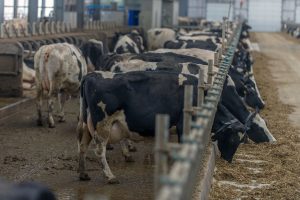
The European Milk Board says many milk producers have gone out of business, because they couldn’t even cover their costs of production in recent years.
Now, as the EU milk supply shrinks, despite record high milk prices at the farm gate, it may be too late to stem the flow of farmers getting out of milk.
The Milk Board (EMB) says the price paid exceeded the cost of production by 2% in Ireland in 2021. What the EMB calls “cost of production” includes “a suitable income for farmers”, which is approximately twice the national minimum wage.
Ireland is the only profitable dairy country in its study, with the milk price falling short in seven other countries, from a 12% shortfall in Denmark to 43% in Lithuania.
This could explain why despite rising prices at the farm gate, EU milk deliveries decreased in 2021 by 0.4%. They are forecast to fall a further 0.6% this year.
In 2021, according to the EU Commission, the EU dairy herd declined by 1.5%. With milk yield growth only slightly above 1.2% (the lowest since 2017), milk deliveries fell.
For 2022, the Commission predicts deliveries falling again, with a small increase in yields (1%) hardly compensating for a 1% decline of the dairy herd. The EMB says the price of milk must cover the production cost and a suitable income for farmers.
For this to happen, it says farmer producer organisations must be strong enough to negotiate with processors, and a socially sustainable Common Agricultural Policy, fair contracts, EU crisis instruments such as a Market Responsibility Programme, and “mirror clauses” on imported dairy products, are all necessary.
But even such developments might not be enough to overcome the effects on dairy farms of this summer’s heatwave and drought difficulties. That was the last thing farmers wanted, even as EMB figures showed German dairy farmers just about returning to profitability this year.
Taking Ireland as an example, the figures calculated for the EMB by the BAL Farm Economics and Rural Studies Office in Germany showed farmers here in 2021 needing 36.23c per kg (0.97 of a litre) of milk to cover costs. These “costs” include an income of €22.70 per hour.
The 36.23c was barely covered by the 36.81c milk price. However, if 3c per litre was needed for re-investment in the farm, there was a shortfall. Seeds, fertilisers, sprays, purchased feed, energy, and maintenance of machinery and buildings cost 19.48c per kg.
Other costs for plant and animals, plus labour, overheads, wages, rent, interest, and taxes came to 15c per kg of milk. After deducting an 8.56c value of calf and cull sales, paid costs were nearly 26c per kg of milk. But, to cater for income, nearly 13c is added, bringing total “costs” to 38.86c.
Also deducted are CAP payments of 2.63c, leaving the Irish milk production “cost” in 2021 at 36.23c.
Dairy farmers in the other seven countries studied did much worse. Compared to a 0.58c shortfall in Ireland, it was 9.87c in Belgium; 9.09c in Germany; 4.89c in Denmark; 15.63c in France; 25.66c in Lithuania; 9.89c in Luxembourg; and 14.16c in the Netherlands.
Across eight member states, in 2021, dairy farmers on average lost 11.21c per kg of milk produced, according to the EMB’s definitions of costs. Only 77% of “costs” were covered. “The cost shortfall will be significantly higher for the first quarter of 2022, due to the dramatic increase in input costs,” said the EMB.
Irish farmers will have to overcome agricultural input prices rising by 41.6%, while agricultural output prices rose only by 28%, according to the latest figures from the Central Statistics Office (CSO).
Fertiliser is now 164% more expensive, energy prices are 50.5% higher, and feed prices rose 32.6% in a year. To compensate, the milk price is up almost 44%.
The EMB lobbies for milk producers in Europe. It has member organisations in 16 European countries, representing about 100,000 milk producers, including the ICMSA in Ireland.

























